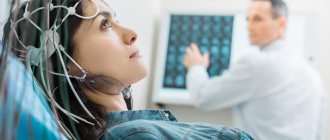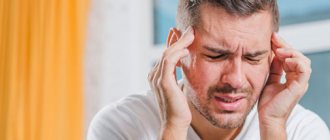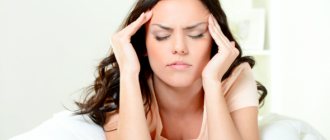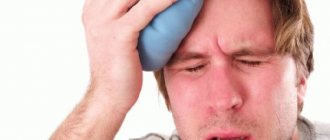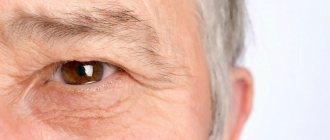Causes
The causes of migraines are not fully understood. It is believed that the attack itself is a regional dystonic vasospasm, which leads to ischemia and changes in the metabolism of nerve cells. There is also a dysregulation of the system of one of the neurotransmitters - serotonin. However, it is much easier to trace the factors that provoke a migraine attack. These factors include:
- Alcohol consumption.
- Drinking coffee and caffeine-containing products.
- Stress and psycho-emotional tension.
- Changes in weather conditions.
- Changing your sleep schedule (either decreasing or increasing sleep time).
- Taking certain medications (primarily hormonal oral contraceptives).
Symptoms
The clinical picture of the disease is very variable, the symptoms of migraine can differ significantly from person to person, despite the fact that the main one is headache.
In this case, we should highlight the most common signs of migraine, the presence of which allows us to make a diagnosis:
- Paroxysmal development of headache with a certain time of its occurrence (from several hours to 2-3 days).
- Localization is predominantly in the fronto-orbital region.
- The monotony of the course of all attacks.
- Presence of nausea, vomiting, photophobia, sound fear.
- High intensity of pain, up to the need to take a lying position.
- Having a family history.
- With concomitant diseases (for example, the consequences of a traumatic brain injury), the patient can clearly distinguish between two different types of headaches.
Note:
“Classical” signs, such as unilateral, throbbing pain, cannot be considered mandatory.
Migraine with aura is also characterized by the development of visual (flickering spots, sparks before the eyes, flashes of light), sensory (impaired sensitivity), speech, and less often motor disturbances, developing within half an hour and completely disappearing in a short period of time. As a rule, the aura develops immediately before the attack, which allows the person to take the medicine in a timely manner.
Migraine in a child
Migraine is a disease familiar to many adults. Unfortunately, this disease often occurs in even young children (according to various sources, in 5–10% of children under the age of 10 years). It is more difficult to correctly diagnose a child, and not only because children cannot always explain the cause of their illness, but also because the signs of this type of headache in childhood are diverse. Often, even pediatric doctors incorrectly interpret not only the headache itself, but also the accompanying symptoms (for example, vomiting, abdominal pain, visual disturbances).
How to suspect a migraine?
Migraine, oddly enough, is the most common type of headache in children, especially younger ones. In early childhood, boys are more likely to suffer from migraines; after puberty, girls get sick more often.
In the youngest patients (cases of migraine have been described in children just over one year old), an attack can manifest itself as a sudden decrease in activity, crying, deterioration in health from loud sounds or bright light. Eyes may become red. Repeated vomiting often occurs. Older children may complain of abdominal pain. Any activity increases pain and malaise.
The pain is often bilateral, affecting the frontal region and eyes (unlike in adults, when the pain is predominantly unilateral) and lasts about 2 hours.
Features of aura during migraine in children
In children, as well as in adults, migraine is distinguished with and without aura. If for migraine without aura the diagnosis is usually not in doubt, then migraine with aura requires a detailed interview with the parents and, if possible, the child. An aura is the symptoms that occur before a headache attack. Unlike adults, aura symptoms in children are more diverse and can flow into one another, making it difficult to make a diagnosis.
For example, an attack may begin with visual impairment, then speech impairment may occur, and then a headache may develop. Special forms of aura have also been described in children. For example, Alice in Wonderland syndrome - during the aura period, the child may feel that he has become small, and the objects around him are huge, or vice versa.
Rare variants of migraine
Sometimes migraine in childhood manifests itself not as a headache, but as other symptoms. For example, cyclic vomiting, paroxysmal (sudden) dizziness that causes unsteadiness, and paroxysmal torticollis (an involuntary spasm of the neck muscles) have been described in children. It is quite difficult to suspect migraine in these cases. To help the doctor in this case, use medical history data: cyclicality and paroxysmal occurrence, cases of migraine in the family.
When to see a doctor
If you suspect that your child has any headaches, you should consult a doctor (pediatrician, pediatric neurologist). Migraine is a disease that is not life-threatening, but in rare cases, more serious diseases (such as intracranial hypertension, sinusitis, brain masses, etc.) can occur under the guise of migraine.
The diagnosis of migraine in a child is beyond doubt if:
- The headache is paroxysmal and lasts about 2 hours.
- One or both halves of the head hurt.
- There are one or more other symptoms - nausea, vomiting, sensitivity to light and sound, abdominal pain.
- The pain decreases after sleep and rest, and intensifies from physical and mental activity.
- In the case of migraine with aura, an aura develops before an attack of pain (it can be varied).
- There is a family history of migraine - one or both parents suffer from this disease.
- Examination by a neurologist revealed no focal symptoms.
Additional examination is carried out if there is reason to suspect other causes of pain. In this case, consultation with an ophthalmologist or otolaryngologist may be required. Instrumental studies (for example, MRI or CT) are performed in children only if absolutely necessary.
Unfortunately, the problem is often the opposite. The child is treated unsuccessfully by an otolaryngologist for sinusitis (due to headaches) or by an ophthalmologist for visual impairment (due to visual aura). The correct diagnosis in such cases is not made immediately, but several years later, when the child grows up and the attacks acquire the typical character of “adult migraine.”
How are migraines treated in children?
The main goal in treating migraines is to reduce the number of attacks and make them easier. It is necessary to exclude the provoking factors of migraine - disturbances in sleep and wakefulness, prolonged watching of TV, nervous overstrain. If a migraine attack does develop, parents should protect the child from bright light, loud sounds, and physical activity.
Most children themselves try to lie down and even fall asleep during an attack. Almost always, if you manage to fall asleep, sleep perfectly relieves pain.
If such measures fail to cope with migraine, the attacks lengthen and become more frequent, then you need to visit the doctor again. It is unacceptable to self-medicate headaches in children!
Be healthy!
Maria Meshcherina
Photo istockphoto.com
Diagnostics
Diagnosis of migraine includes a thorough collection of complaints and medical history. Often, characteristic complaints, as well as the absence of objective neurological disorders, allow a diagnosis to be made.
However, occasionally it is necessary to clarify the diagnosis and exclude focal brain lesions, hydrocephalus and other pathological conditions. In such cases, they resort to neuroimaging research methods (MRI, MSCT, etc.), neurophysiological research (EEG, REG, polysomnography), and the general clinical minimum.
Treatment and prevention
Unfortunately, treating migraine is a rather long and expensive process. It should be said that the indication for hospitalization in a neurological hospital is only diagnosed complicated migraine and the presence of migraine status (duration of severe pain more than 72 hours); other cases are treated on an outpatient basis. In an outpatient setting, you can use the complex effects of drug and non-drug therapy, normalization of the daily routine and lifestyle modification. Among the drugs used for migraine are vascular drugs, drugs that affect the serotonin system, non-steroidal anti-inflammatory drugs, and antiepileptic drugs.
Non-drug methods of therapy include massage of the collar area and scalp, as well as some physiotherapy. Electrosleep is very effective, as it significantly reduces the frequency of attacks.
Normalizing the daily routine consists, first of all, of maintaining a strict sleep schedule, excluding lack of sleep, as well as excessively long periods of sleep. Among the general recommendations, it should be noted the need to exclude a number of foods from the diet (primarily alcohol), as well as regular exercise therapy.
More detailed information about migraine medications, dosages, treatment regimens, and general recommendations can be found in the following article (read the article!).
Simple migraine
Standard analgesics are ineffective in relieving migraine paroxysm. As a rule, dihydroergotamines (ergotamine, dihydroergotamine) or selective serotonin agonists - triptans (sumatriptan, rizatriptan, naratriptan, zolmitriptan, eletriptan) are used. With the gradual development of paroxysm, it is enough to take one of these drugs orally. However, due to reduced gastrointestinal motility, this method of administration may be ineffective. In such cases, the use of ergotamine in rectal suppositories, dihydroergotamine intramuscularly or intravenously, sumatriptan subcutaneously is recommended. The use of triptans is associated with frequent relapses of cephalalgia, since these drugs have a short half-life (only 2 hours). When cephalalgia recurs, it is often necessary to take the medication again, combining triptans with non-steroidal anti-inflammatory drugs (ibuprofen, nimesulide, diclofenac).
In some cases, simple migraine is relieved by endonasal administration of lidocaine, taking naproxen, and intramuscular administration of magnesium. Repeated vomiting is an indication for the use of antiemetics (metoclopramide, domperidone, ondansetron). With high intensity of cephalalgia and no improvement from the use of the above pharmaceuticals, they resort to the use of narcotic analgesics (tramadol, trimeperidine, codeine, fentanyl, nalbuphine). However, their use is possible no more than 2 times a week.
Unfortunately, at present, simple migraine does not have effective pharmacotherapy during the interictal period, which would significantly reduce the likelihood of a migraine attack. Neurologists use monoamine oxidase inhibitors, beta-blockers, tranquilizers, anticonvulsants, oxytriptan (a precursor to serotonin), etc. Some domestic studies have shown the effectiveness of long-term use of small doses of aspirin.
Since drug treatment is ineffective, great attention should be paid to the patient’s lifestyle and the exclusion of factors that provoke a migraine attack. This is a task that only the sickest person can solve. In addition to normalizing the daily routine and nutrition, this should include serious psychological work aimed at reducing demands on others and developing a more friendly attitude towards people. Consultations with a psychologist, special training, and psychotherapy can play a supporting role in this.
Forecast
A simple migraine in itself is not a disease threatening the life or health of the patient. However, migraine attacks reduce the performance of patients, making it impossible for them to perform their work duties during the attack. In addition, some patients (for example, rescuers, doctors, workers in noisy workshops, cooks, etc.) are forced to change their profession because it is associated with migraine triggers. Unfortunately, according to statistics, only in 10% of cases doctors manage to achieve cessation of migraine paroxysms. On the other hand, there are numerous cases where patients themselves, by changing their lives, achieved recovery.

